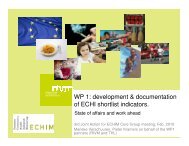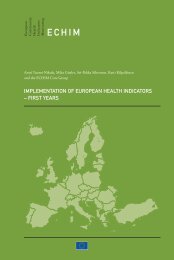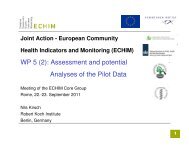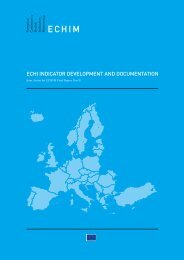INDICATORS
ECHIM Final Report
ECHIM Final Report
You also want an ePaper? Increase the reach of your titles
YUMPU automatically turns print PDFs into web optimized ePapers that Google loves.
6. POPULATION BY EDUCATION<br />
Definition: Total number and proportion (%) of population divided up into 3 classes of<br />
educational attainment (low, middle and high education). Attainment profiles are based on<br />
highest completed specified level of education. The International Standard Classification of<br />
Education (ISCED-97) is used to define the levels of education.<br />
Calculation: Total number and percentage of total population in the 7 classes of ISCED<br />
(International Standard Classification of Education 1997), aggregated into three attainment<br />
groups comprising of:<br />
Low or Basic education: 1) no formal education or below ISCED1, 2) Primary or 3) Lower<br />
secondary;<br />
Middle or Secondary education: 4) (Upper) secondary, or 5) Post-secondary non-tertiary;<br />
High or Tertiary education: 6) First stage of tertiary, or 6) Second stage of tertiary education.<br />
Notes: Usually calculated for the population aged 25 to 64. Ideally calculated for the whole<br />
population, but unfortunately the educational level of the non-active population and the<br />
deceased is seldom known / recorded.<br />
7. POPULATION BY OCCUPATION<br />
Definition: Total number and proportion (%) of population by occupational group.<br />
Classification is based on the current or last (main) occupation. Last (main) occupation is<br />
preferred, but that information is seldom available. If not available, use current occupation<br />
instead.<br />
Calculation:<br />
1) SES project recommends 6 occupational groups: upper non-manual, lower non-manual,<br />
skilled manual, unskilled manual, self employed, farmer/entrepreneur.<br />
2) A new “European Socio-Economic Classification (ESeC)” scheme is in preparation<br />
(Eurostat project).<br />
Notes: Current and last occupation. Ideally the current or the last (main) occupation of<br />
the non-active population and the deceased is recorded. Only by using the last (main)<br />
occupation can e.g. the retired be classified into an occupational group.<br />
8. TOTAL UNEMPLOYMENT<br />
Definition: Proportion of unemployed persons in active population in %. The active<br />
population (labour force) is the total number of people employed and unemployed.<br />
Unemployed persons are all persons who were not employed during the reference week,<br />
had actively sought work during the past four weeks and were ready to begin working<br />
immediately or within two weeks.<br />
Calculation: Eurostat: Proportion of unemployed persons in active population in %, derived<br />
from The European Union Labour Force Survey. Average number in a given year.<br />
Notes: Active population is usually defined as 20–64 year-olds or 15–74 year-olds.<br />
“Unemployment rate by gender” is one of the EU structural indicators.<br />
88










